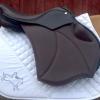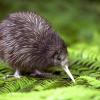
DebSweet
Members-
Posts
15 -
Joined
-
Last visited
Profile Information
-
Location
USA
-
Interests
Handbags and tote bags
LW Info
-
Leatherwork Specialty
Sewing
-
Interested in learning about
Gun holsters
-
How did you find leatherworker.net?
Looking for sewing machines recommended
DebSweet's Achievements

Member (2/4)
-
Edited Singer 31-15 US Aircrew Survival Equipmentman Chapter
DebSweet replied to akira7799's topic in Sewing Leather
Oh , thank you for this .pdf, very much!! -
Actually, I'm all set. I was able to find the guy I bought the last bit of leather from; he had some more of it and I bought it. Hooray! As for the dogs, both are rescues. My dog is a big Labrador that had had several homes before me; some of his leash skills were *ahem* 'less than'..but there isn't a darn thing wrong with his scent tracking. Hence, the need for Heavy Duty leash #1. (And a Herm Sprenger prong collar) My other halfs' dog is a Cattle Dog X that was supposed to have been fully grown and with her head on straight. She's a puppy. She's positively goofy on leash. I have no idea how big she will be. She's hard-headed about this leash walking business; hence the need for Heavy Duty leash #2. She will also be fitted for a prong collar. Thank you all for being willing to help.
- 5 replies
-
- leather
- dog equipment
-
(and 1 more)
Tagged with:
-
Purse maker here. What you need is called 'interfacing' or 'interlining'. It comes in a variety of weights and types; I could be here half the day describing or debating the stuff. Every type has it's highest and best use. That said.. I'm not sure what the various weights or brands of interfacing are called in the UK. However, if you ring one of the local purse makers who make bags out of Harris Tweed, they should be able to help guide you to the appropriate selection of interfacing; they've pretty much got it down to a science. If all else fails, try your local fabric shop. There should be a selection of interfacing there to choose from. Hope this helps!
-
Your dog is beautiful! Where did you find that D-ring, please?
-
I have had dogs with allergies, and newly adopted dogs with skin issues that had to heal, but who still had to wear a collar. Here is what I had good luck with, and I hope this helps someone! Some dogs have metal allergies; even good stainless steel can cause a reaction. Some dogs also have nylon/plastic allergies (fairly common). However, these same dogs usually won't react (in my experience anyway) to powder coated hardware. You just need to keep an eye on the powder coat because it will chip over time. For dogs with leather, material, dye, or just collar rubbing the wrong way issues, padding works. What I did was make removable collar covers to slip the collar into--old towels work great for a cheap and temporary solution to test to see if that's the problem. If you want something that looks a little better, look into working dog collars that have padded linings; I've seen some made of leather and lambswool at dog shows. If you still have questions, please feel free to ask; I'm happy to help where I can.
-
Hi. I'm looking for a 1/4" or so thick strap that is about 1" wide, finished on both sides and about 5' long. This would be for a dog leash for a serious puller. (She's a recent rescue who is just learning her manners and oh my is she stubborn. Where would I order such a thing, please? Thank you!
- 5 replies
-
- leather
- dog equipment
-
(and 1 more)
Tagged with:
-
Attention gearheads into old Singer sewing machines. I know that most of you are into old industrials, but on the off chance someone is into an old domestic as a winter project to sew bag or wallet linings, here's one: I have a 1940 Singer 15-91 (potted motor) for parts or restoration. I got it to make bags. I never made it that far. The previous owner, as it turns out, put oil where it didn't belong and didn't tell me, so when I ran it for the first time, the wires leading to the motor failed. It's my understanding that this can be fixed, but the sewing machine hospital closest to me doesn't know how to fix it, and I lost interest in playing with it, as I discovered an industrial that will do what I was aiming to do in the first place. The parts are all there. I still have the presser feet, etc. that it came with. $20 bucks to take this thing off of my hands in Chesapeake Va. It's worth it just for the pretty parts and the presser feet. If you're interested and want pictures, PM me with your email address and we'll go from there, as the picture thing here on the site doesn't want to play nicely with me today .
-
- domestic sewing machine
- singer
-
(and 1 more)
Tagged with:
-
Free wooden Singer _domestic_ sewing machine cabinet for refinishing. It used to hold a 1940 Singer 15-91. It will probably hold other domestic machines of the same era, but I am certainly no expert by a long shot. The cabinet is not a pretty sight right now. It's former owner (I didn't do it!!) tried to Pinterest it for his wife..and failed miserably. When I got it, I elected to try to strip the veneer and paint it. I got a goodly chunk of the hopelessly damaged veneer removed, only to find another layer of veneer. So maybe the guy tried twice? I don't know. Anyway.. The drawers are all there, along with the multi-spool pin holder, etc. Long story short, I discovered vintage industrial machines in between the acts and that, was the end of that, because I finally had the punching power necessary to do what I am aiming to do. Please come take this cabinet off of my hands in Chesapeake Va. Ours is a non smoking household, but we are cat and dog friendly. I do believe that the previous owner of the cabinet smoked--but I did get the smell out, I think. No charge, but you haul it out. It will fit just fine in the back of a Jeep Cherokee. If you would like a photo, message me with your email address because the photo editor here doesn't want to play nicely with me today.
-
Heaven forbid I break a needle.
-
I am wondering what folks use for eye and face protection while sewing. Plain old everyday glasses, safety glasses, face goggles, or something else? While working with my 31-15 (I'm still finding filthy places on her!!) I've been wearing goggles, but I am hoping for the day where I can switch off to something more comfortable, and I am looking for recommendations from the 'been there; done that' crowd in order to shorten my learning curve. Thank you!
-
I don't actually have a 29 class patcher..yet. There is a guy near me that is selling one, however. This leads me to my question. I had heard talk somewhere (here, maybe?) that a 29K-something machine made it possible to sew motorcycle club patches on jackets with the stitches on the back of the peice going in between the lining and the back side of the leather. I am having a hard time visualizing the process. What I'm thinking is that the lining has to have a stitch line unpicked then the patch applied, then the lining of the garment re-stitched to the garment proper. Surely I am overthinking / overcomplicating this. Would someone walk me through the process of how one puts a patch on a leather jacket without sewing through the lining, please? Thank you!
-
I own the precursor to this machine, aka the New Home L-372. I bought it new off of the showroom floor back in the late 90s. So I've had it for awhile and I have put it through its paces. In a nutshell, don't try and stitch anything too terribly thick with it, and do be aware that a loose thread bit in the bobbin area can cause an obscene amount of trouble.
-
Hi! A local sewing machine mechanic was clearing out his workshop and I managed to bring home a 31-15 with motor and table. I am thrilled to bits with my first industrial machine, even if it is still ungodly filthy at the moment. It's cleaning up, slow but sure. I have bobbins and a pack of needles and a straight stitch presser foot. And she sews and the motor works and all of that. However, I have some questions. This is my first industrial machine and I'm discovering that the world of industrial machines is much different from domestics, so please be kind. I understand that this machine takes #69 thread. Where is the best place to order that, please? I also need a zipper foot and a 1/8" topstitching foot. Where would I order such things from, please? Last but not least, I have a question about my sewing table. When I took the machine out of the table to clean it, there were what looked like some wool felt thingies that just disintegrated. My guess is that they are, or were, vibration dampeners. Clearly I need some new ones. I can't find any mention of these things in my copy of the owners manual. What are these darn things called, is there a modern equivalent, and where do I purchase them, please? Grease. Will the grease from the auto parts store do or do I need something else? Grease wicks. Are there any in this machine? Last but not least, I'm a big believer in RTFM. I am looking for a repair and adjustment manual. Does anyone have a PDF copy, please? Thank you!




